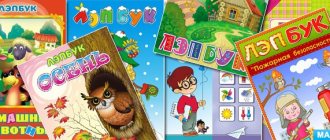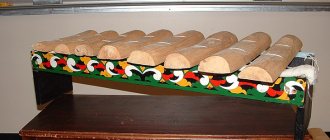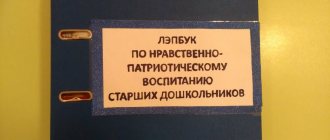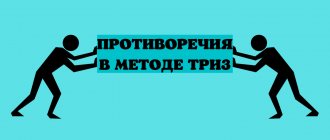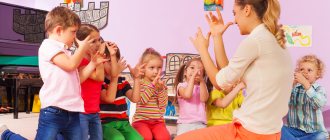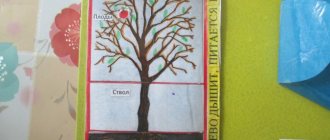“Using a lapbook when introducing preschoolers to their native land”
“Using a lapbook when introducing preschoolers
with the native land"
In order to meet modern requirements, teachers of preschool educational organizations need to constantly study, engage in self-education, and improve their level of professional competence. It is important to learn to adequately respond to ongoing changes in the field of education, be able to work in a team of like-minded people, competently and efficiently organize work with students, effectively build partnerships with their parents to solve educational problems, independently select the content of education and adapt it taking into account age and individual characteristics of children of a particular group, focusing on the requirements of the Federal State Educational Standard for preschool education.
In connection with the implementation of the Federal State Educational Standard for preschool education, every teacher is looking for new approaches and ideas in their teaching activities. So we began to study and use in our work a completely new, interesting and irreplaceable teaching aid - a lapbook.
It can be used both in kindergarten and at home. A laptop is interesting and useful because it is made jointly by an adult and children.
The relevance of this topic is that a lapbook is an excellent way to consolidate and repeat materials from a project or thematic week.
What is a lapbook?
Lapbook – literally translated from English means “knee book” (lap – knees, book – book). This is a small homemade folder that a child can conveniently lay out on his lap and view all its contents at one time. But, despite its apparent simplicity, it contains all the necessary
Lapbook on historical local history
LAPTOP “OUR LANDSCAPE DURING THE GREAT PATRIOTIC WAR”
In 2022, our country celebrates the 75th anniversary of Victory in the Great Patriotic War
.
Many events dedicated to the celebration of Victory Day have taken place and are taking place. We also couldn’t ignore this topic - we made a lapbook about the war
.
Let us explain a little what a lapbook is. came to us from America
.
Literally translated from English, “ lapbook
” means “knee book” (lap - knees, book - book).
A laptop
is a thematic or interactive folder, that is, a homemade paper book with pockets, doors, windows, and movable parts that can be taken out, rearranged, and folded at your discretion.
The laptop “Our Land during the Second World War” is a product of the research activities of high school students for use in primary and secondary levels.
Relevance of the project:
The theme of the Great Patriotic War is extremely relevant in modern society, it contributes to the unification and cohesion of our people. Victory Day is close and understandable to any age.
Why did we choose the form - lapbook?
1. Kids know some facts about the Second World War. But even many high school students do not know about the participation of our region in these events. We believed that the Lapbook would help the children, if they wish, organize information on the topic and better understand and remember the material.
2. At any convenient time, you can simply open our laptop and find the pocket you are interested in.
3. We can use the laptop in mini-groups and individually.
Our lapbook includes 10 educational pockets:
1. Mini-book “Monuments of the Second World War in our city and region”
2. Pocket with cards “Heroes of the Soviet Union of the Shuiskaya Land”
3. Envelope “Shuya-front” - origami
4. Postcards-congratulations to veterans
5. Envelope “Awards of our heroes” - provides information about the most famous awards awarded during the Patriotic War
.
6. Pocket “Coloring Books”
7. Pocket “WWII equipment”
8. Pocket “WWII Awards”.
9. Street of Heroes pocket
Each of you can make such a lapbook. Let's give some advice.
Plan
Once you have chosen a topic, you need to take paper and pen and write an outline. After all, a lapbook is not just a book with pictures. This is a tutorial. Therefore, you need to think about what it should include in order to fully cover the topic. And for this you need a plan of what you want to tell in this folder.
Layout
The next stage is the most interesting. Now we need to figure out how each of the points of the plan will be presented in the lapbook. That is, draw a layout. There are no limits to imagination here: presentation can take any form. From the simplest - text, to games and educational tasks. And place all this on different elements: in pockets, notebooks, mini-books, accordion books, rotating circles, envelopes of various shapes, cards, fold-out pages, etc. and so on.
What do you need to make a lapbook?
To create a lapbook you will need the following materials:
- Cardboard base folder. You can buy it ready-made, or you can make it yourself.
- Plain paper.
- Scissors.
- Glue stick for paper.
- Stapler.
- Scotch.
In accordance with the layout, make a full-size folder template. We cut out the parts and glue everything in place.
Conclusion
We were born in a happy, peaceful time, but we heard a lot about the war. After all, this misfortune has not spared our relatives either.
We are very proud of the exploits, strength and courage of our dear people - our great-grandfathers and great-grandmothers! We all remember and love them very much. And we will always remember. May their memory be blessed! Every year, on the ninth of May, we go to the solemn parade and lay flowers at the Eternal Flame, mentally saying: “Thank you to all of you who gave us peace. Eternal memory to you!
Think about it, after all, a little more and only one eyewitness to the Second World War will remain. The defenders of our Fatherland, those who shed blood for us have long been gone, only the children of war remain, and even they do not always manage to convey the anguish, the pain that the people experienced at that terrible time.
After all, someone’s great-grandmother dug trenches, someone had relatives in evacuation, and in the rear they worked for the front. Or maybe in besieged Leningrad they survived the bombings and fainted from hunger, and buried their loved ones. Some were in a concentration camp, while others cared for the wounded and washed clothes for the soldiers. Some relatives extinguished lighters on the roofs of cities and distributed triangles - letters from the front. Some people's grandfathers shed blood for their Motherland in battles at the front, while others were partisans and fought behind enemy lines for our future.
Yes, almost every family was touched by the war. How much pain, suffering and torment our ancestors endured! Children should know how people lived in that terrible time!
The alarm bell sounds the words of Robert Rozhdestvensky, addressed to all humanity: “People!!!
While hearts are knocking, -
Remember!!!
At what cost
Happiness has been won -
Please remember!!!"
The pages of human history, which were written with the tears and blood of millions of people who fought against the invaders, should not be forgotten.
While working on the research using the example of our region, we learned a lot about wartime, about the people who made their invaluable contribution to the Victory over fascism. Now we must introduce this information to as many people as possible. This is the practical significance of our work. We believe that our project - the lapbook “Our Land during the Second World War” can be used in Courage lessons, classroom hours dedicated to the Great Patriotic War and home front workers.
Lapbook “My Perm Region”
Municipal autonomous preschool educational institution "Platoshinsky kindergarten "Solnyshko"
Lapbook on the topic: “My Perm region”
Author-compiler: Medvedeva Elena Nikolaevna
teacher
Municipal autonomous preschool educational institution "Platoshinsky kindergarten "Solnyshko"
Lapbook on the topic: “My Perm region”
Author-compiler: Medvedeva Elena Nikolaevna
teacher
Target:
development of children’s coherent speech using the didactic manual lapbook “My Perm Region”.
Tasks:
- Develop coherent speech in children.
- To form children’s ideas about their small homeland.
The “My Perm Region” laptop is a homemade folder with pockets, notepads, accordions, envelopes, and movable parts that a child can take out, rearrange, and fold at his own discretion.
On the first page, it is called “Cities of the Perm Territory”, there are:
- Envelope “Cities of the Perm Territory”, in the envelope there are photos of the most famous cities of the Perm Territory, interesting facts about them.
- Notebook “Coats of arms of the cities of the Perm region” with illustrations of the coats of arms of the most famous cities,
- Accordion “Proverbs of the native land”,
- The “This is Interesting” envelope contains information about the most interesting places in the Perm region.
- Pocket “Puzzles “Hometown””, in which there is an image of the symbol of the city of Perm and a set of puzzles.
The second page is called “The Pride of Our Land” and contains:
- Four envelopes on the topic: “Famous people of the Perm region”, “What is the Perm region famous for”, “Minerals”, “The most unusual monuments of the Perm region” with an image and their description,
The third page is called “Animal World”, it contains:
- Envelope “Red Book of the Perm Territory”, which contains cards with images of animals, birds, fish listed in the book.
- Secret "Riddles about animals."
- Accordion "Classification of Animals".
- Envelope “Creative task”, the purpose of which is the development of coherent speech (retelling, conversation, reading).
- Memory game, the purpose of which is to consolidate knowledge of the appearance and names of animals, birds, fish of the Perm region; the ability to distinguish and compare pictures with each other, name them correctly; development of memory, ability to concentrate.
The fourth page is called: “Plant world”, it contains:
- Three envelopes with illustrations on the theme: “Trees”, “Herbs”, “Mushrooms”;
- Envelope on the theme: “Color the plant”
- Envelope "Tale based on the picture."
Also in the lapbook there is an application that contains mnemonic tables that help to compose descriptive stories (“Tell about the animal”, “Tell about the plants”, “Tell about the birds”, “Tell about the insects”). Didactic games: “Verbal game “Why”, “Accounting Pedestal”, “City Coat of Arms”, “The Fourth Odd One”, “Animals of Our Land” - which are aimed at developing coherent speech, and also help consolidate knowledge of the material collected in the folder.
7
Lapbook as a type of project activity “My Altai has many faces”
- December 5, 2016
Competition “Lapbook as a learning tool in the conditions of the Federal State Educational Standard”
Nomination “Use of a laptop in the pedagogical activities of a preschool teacher”
Goal: to create conditions for the effective use of new technology - an interactive folder (lapbook) to consolidate children's knowledge about their small homeland - the Altai Republic.
Tasks:
1) study and select material on the topic “Getting to know the Altai Republic”; 2) make diagrams, pockets, plot pictures, photos; 3) expand children’s ideas about their native republic, know the location of regions, mountains, rivers, lakes; 4) to form ideas about the Motherland, filling it with emotionally rich content that is meaningful for children, to introduce them to the symbols of Russia and the Altai Republic; 5) consolidate knowledge about the sights of our republic, nature and its wealth; 6) arouse interest in the life of people, flora and fauna; 7) cultivate respect for the traditions of one’s own and other peoples; organize master classes on making lapbooks with parents.
2) make diagrams, pockets, plot pictures, photos; 3) expand children’s ideas about their native republic, know the location of regions, mountains, rivers, lakes; 4) to form ideas about the Motherland, filling it with emotionally rich content that is meaningful for children, to introduce them to the symbols of Russia and the Altai Republic; 5) consolidate knowledge about the sights of our republic, nature and its wealth; 6) arouse interest in the life of people, flora and fauna; 7) cultivate respect for the traditions of one’s own and other peoples; organize master classes on making lapbooks with parents.
Stages of working on a laptop:
- At the preparatory stage, we studied materials about lapbooks from the methodological magazine “Preschool Education”, from the site “This is Interesting!” (tavika.ru);
- The main stage is the creation of a lapbook “My Altai has many faces,” which consists of 10 developmental elements.
- at the final stage we plan to organize an exhibition of lapbooks - joint works of teachers, parents and children on various topics: “Lazar Vasilyevich Kokyshev - two paths: creative and life!”, “Types of Altai national dwellings”, “Altai fairy tales”, “G.I. Choros-Gurkin – artist of Altai”, etc.
The interactive thematic folder “My Altai has many faces,” which we made together with the children, will store lesson materials about our Altai Republic. This folder consists of 10 developmental elements :
1. Envelope in the shape of mountains – didactic game “Symbolics of the Altai Republic”. Here you can find the games “Gather a Picture” (make a whole from parts) for younger preschoolers, and for older children – analysis of colors and images on symbols, as well as “Smart Stripes”.
2. Mini-book “Altai proverbs and sayings, folk riddles” for guessing riddles on the topics “Nature and natural phenomena”, “Plants”, “Animal world”, “Pets”, “Man and his life”, “Homeland. People”, etc. It is designed to train memory and intelligence. Each page has a riddle with picture answers (riddles and proverbs are added as you become more familiar with the topic).
3. Figured envelope “Regions of the Altai Republic”, cards are placed in the envelope. Children should know the regions of the republic. What is this or that area famous for? There is also a map of the republic, folded in four (the child unfolds it when completing the task).
In the middle of the lapbook there is a green background, symbolizing the vegetation and wealth of the republic.
4. Accordion book “Animals of the Altai Republic”. Serves to enrich the child’s knowledge about the surrounding nature of his republic, including animals and their habitat, rare animals listed in the Red Book.
5. “Nature of the Altai Republic” is presented in the form of an ordinary colorful book and a figured envelope - a flower, in which there are plot pictures of mountains, lakes and rivers, photographs where children consolidate knowledge and show admiration for the beauty of the world around them.
6. Figured book “Writers, artists, poets, storytellers of the Altai Republic.” Children talk about famous people of the republic, name their works, and are proud of them.
7. Envelope “The capital of the Altai Republic is the city of Gorno-Altaisk,” which contains photographs of the old and modern city of Gorno-Altaisk, the capital of the Altai Republic. Children compare how the city has changed and name the sights.
8. The educational element “Altai Ornament” will help the child not only name patterns correctly, but also prepare for writing. Children draw patterns based on the model.
9. The transparent envelope “Make a story based on the picture” is aimed at reinforcing the compilation of descriptive stories based on the reproduction of a painting by Altai artists.
10. The creative task “Color and Tell” contains a variety of tasks for the development of not only creative abilities, but also cognitive and communicative ones.
Our little flip book packed a lot of information into a very attractive and interesting format. But everyone can do it in their own way and, most importantly, together with their children. Children treat the product of their creativity very carefully and proudly tell and show it.
Such an unusual presentation of the material will definitely attract the child’s attention, and he will return to this folder more than once to look through it, play with it, and at the same time, unbeknownst to himself, repeat the material he has covered.
Effectiveness of using a laptop:
1. A laptop is an effective tool for cooperation with parents of students. Parents provide support:
- organizational (excursions, hikes, trips)
- technical (photos, videos, drawings)
- cognitive and informational (collecting information for a laptop)
- motivational (maintaining interest, creating a situation of success)
2. Working with a lapbook meets the main theses of organizing partnership activities between an adult and children, as pointed out by N.A. Korotkova:
- involvement of the teacher in activities on an equal basis with the children;
- voluntary participation of preschoolers in activities (without mental and disciplinary coercion);
- free communication and movement of children during activities (subject to the organization of the workspace);
- open time end of activity (everyone works at their own pace).
3. The laptop meets the requirements of the Federal State Educational Standard for Educational Education for a developing subject-spatial environment: it is informative, multifunctional, and promotes the development of creativity and imagination. Suitable for use by a group of children at the same time (including with the participation of an adult as a playing partner); has didactic properties; is a means of artistic and aesthetic development of the child, introduces him to the world of art; its structure and content are accessible to preschool children; provides playful, educational, research and creative activity for all pupils.
As a result of using a laptop, children develop:
- ability to plan upcoming activities;
- negotiate with peers;
- independently provide explanations to questions that arise;
- make your own decisions based on your knowledge and skills;
- distribute responsibilities;
- search for the necessary information, summarize it, systematize it;
- make your own decisions based on your knowledge and skills;
- Using oral speech, express your thoughts and desires.
Thus, we can say that a lapbook on the topic “My Altai has many faces” is a collective image of a book and handouts that is aimed at developing creative potential in preschoolers, broadening their horizons, developing the skills and abilities necessary to overcome difficulties and solve the problem - consolidation of knowledge about the Altai Republic.
I would like to note that this form of work helps to create conditions to support children's initiative and creativity in the group. In the process of such creativity, the child becomes not only the creator of his own book, but also a designer, illustrator, and writer of his own stories, riddles, and poems. This exciting form of work creates conditions for the development of the child’s personality, motivation and abilities not only in preschool age, but also at the school stage.
This form of work in child-adult interaction, both together with teachers and family projects, develops more trusting relationships when working with families, increases parental (professional) competence and makes it possible not only to recognize the interests and potential of a preschooler, but also to develop them.
Lapbook “My Altai has many faces”
Author: Natalya Mikhailovna Tanzykova, teacher, kindergarten “Topolyok”, Municipal Educational Institution “Paspaulskaya Secondary School”, Altai Republic, S. Paspaul.
